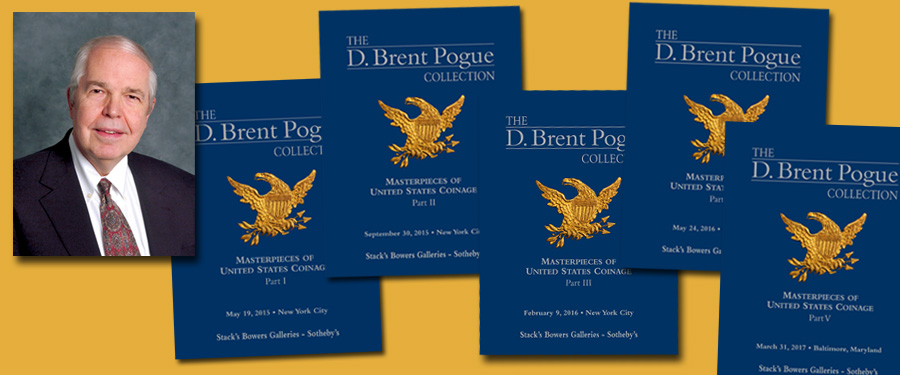
It seems like only
yesterday, but it was in January 2014, slightly over three years ago, that
Chris Karstedt and I went to Dallas to plan the presentation of the D. Brent
Pogue Collection on behalf of Mack Pogue and his son Brent. Mack and Brent had
been friends for many years. I have many nice memories of both attending a
number of our landmark auctions—such as the 1979-1981 Garrett sales for the
Johns Hopkins University and our October 1982 sale of the Louis E. Eliasberg
Collection of United States Gold Coins. Beyond that, Brent on his own has
attended more of our sales and events than I can count! Along the way we became
close friends.
Brent, who took the lead
in forming the collection, was and still is a connoisseur par excellence.
Starting as a teenager, time was on his side. He began in the right way—by
assembling a fine working library of standard reference books and auction
catalogs. As obvious as this may seem as a path to success, relatively few
collectors do that. Today in 2017 many people will spend, say, $1,600 on a
common-date double eagle, but if I suggest that they spend the same amount on
books, only a few will do so.
In brief, there is no
substitute for knowledge when it comes to forming collection. Although the
Internet, price lists, and other sources beckon, there is no better way to gain
knowledge than by purchasing books that give information about coin designs,
minting procedures, and more.
Today if I were at a
convention and was arranging a program, and a speaker was delayed in arriving,
I could ask Brent, “Could you give a program on coins of the 1790s?” and he
could do it superbly, and without preparation.
As we conclude Part V of
our D. Brent Pogue Collection auction series, there is still more to do with
the Pogue family. This includes completing a book that will be an overview of
numismatics from 1792 to 1840, the main focus of the coins we sold in the first
five sales, plus glimpses of the American scene during that time.
When I contemplate the
pleasures I have had in numismatics ever since I became a professional
numismatist in the 1950s I have had more fine experiences than I can count. A
short list includes interviewing and taking notes on the lives of many famous
numismatists such as B. Max Mehl, Abe Kosoff, James O. Sloss, Stephen K. Nagy,
Ed Rice and others. Other highlights included buying of the Lenox R. Lohr
Collection of pattern coins in 1961 for $100,000 (it had seven of the nine 1792
issues) from Abner Kreisberg; being on hand and taking notes during the great
Treasury release of silver dollars in 1962 and 1963; researching and writing
several dozen books (mostly with Whitman Publishing Company in the past 14
years); acting as president of the PNG and ANA, and being front row center in
the historical research and marketing of coins from the treasure ships S.S.
New York, S.S. Central America, and S.S. New York. Then there are
the great collections: T. Harrison Garrett and John Work Garrett, Virgil M.
Brand (selections), Louis E. Eliasberg, Ambassador and Emery May Holden Norweb,
and Harry W. Bass, Jr. To this list I can now add the D. Brent Pogue
Collection.
Of all my assets, the
best are friendships with coin people: collectors, dealers, scholars in
numismatics and general history, Mint officials, along with staffers at Stack’s
Bowers Galleries and other companies in which I have been involved. The Pogue
family is high on that list as well. How fortunate I have been.
When I first started,
numismatics was called the world’s greatest hobby. In my opinion, today in 2017
it still is.





